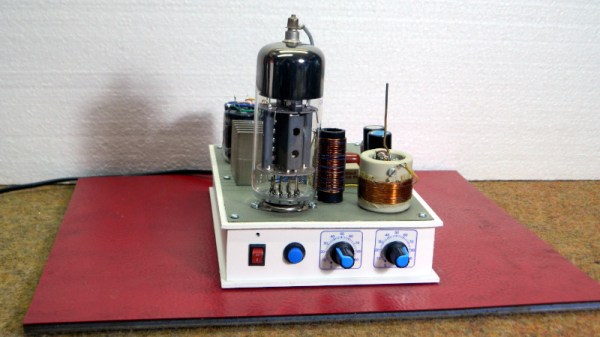In the world of audio there are a huge variety of esoteric technologies which are rarely seen. One such is the plasma tweeter, a type of loudspeaker which generates sound by modulating a small electrical discharge. The benefit of this design comes in its delivering the closest possible to a point audio source, in effect the theoretical ideal speaker for treble frequencies. They’re a little hazardous due to the voltage but aren’t too difficult to make, as demonstrated by [Mircemk] whose version uses a recycled power pentode tube — which is how it showed up in the Hack it Back round of the Hackaday Prize.
It can be thought of as a cousin of the Tesla coil, with the same resonant oscillator but no capacity hat. Instead the top of the coil ends in a point, from which in the perfect speaker a ball of plasma replaces the Tesla’s impressive sparks. In this case the pentode is joined by a high-voltage TV line output transistor as a bias supply, which is in turn modulated with the audio through a small amplifier. It sometimes needs the plasma teasing out of it through discharge to a screwdriver, but the result is a very effective and clear plasma tweeter.
If plasma tweeters interest you, we’ve featured them before.





 A look at the circuit diagram and construction will probably elicit the response from most of you that it looks a lot like a Tesla coil, and in fact that’s exactly what it is without the usual large capacitor “hat” on top. This arrangement has been used for commercial plasma tweeters using both tubes and semiconductors, and differs somewhat from the singing Tesla coils you may have seen giving live performances in that it’s designed to maintain a consistent small volume of discharge rather than a spectacular lightning show to thrill an audience.
A look at the circuit diagram and construction will probably elicit the response from most of you that it looks a lot like a Tesla coil, and in fact that’s exactly what it is without the usual large capacitor “hat” on top. This arrangement has been used for commercial plasma tweeters using both tubes and semiconductors, and differs somewhat from the singing Tesla coils you may have seen giving live performances in that it’s designed to maintain a consistent small volume of discharge rather than a spectacular lightning show to thrill an audience.









